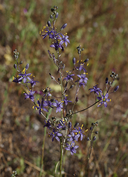Taxon Report
Hooveria purpurea (Brandegee) D.W. Taylor & D. J. Keil var. purpureaSanta Lucia purple amole |
 © 2006 Aaron Schusteff |
Taxon Summary
Hooveria purpurea var. purpurea, commonly known as Santa Lucia purple amole, is a perennial bulbiferous herb in the Agavaceae that is found only in California. It occurs within Chaparral, Cismontane woodland, and Valley and foothill grassland, growing at elevations from 205 to 385 meters. Hooveria purpurea var. purpurea is ranked 1B.1, Plants Rare, Threatened or Endangered in California and Elsewhere; Seriously threatened in California.Classification
|
Scientific Name: |
Hooveria purpurea (Brandegee) D.W. Taylor & D. J. Keil var. purpurea |
|
Common Name: |
Santa Lucia purple amole |
| Family: | Agavaceae |
| Element Code: | PMLIL0G051 |
| USDA Plants Symbol: | CHPUP2 |
|
Synonyms/Other Names: |
|
Ecology and Life History
| Lifeform: | perennial bulbiferous herb |
| Blooming Period: Apr-Jun | Apr-Jun |
| Elevation: | 205-385 (675-1265) |
| General Habitats: | Chaparral, Cismontane woodland, Valley and foothill grassland |
| Microhabitat: | Clay, Gravelly |
| Microhabitat Details: |
Conservation Status
| CA Rare Plant Rank: | 1B.1 |
| Global Rank: | G2T2 |
|
State Rank: |
S2 |
| State List: | None |
| Fed List: | FT |
| Other Status: | SB_SBBG |
|
CRPR Changes: |
|
Occurrence Data from the CNDDB
| Total Occurrences: | 17 |
| Element Occurrence Ranks: | |
| Excellent (A) | 1 |
| Good (B) | 7 |
| Fair (C) | 0 |
| Poor (D) | 1 |
| None (X) | 0 |
| Unknown (U) | 8 |
| California Endemic: True | |
| California Counties and Islands: Name (Code) | |
| Monterey (MNT), San Luis Obispo (SLO) | |
| Quads: Name (Quad Code) | |
| Bradley (3512077), Burnett Peak (3512172), Cosio Knob (3612112), Jolon (3512182), Williams Hill (3512181) | |
Threat List Data from the CNDDB
| Threat List Total: | 11 | |
| EOs with Threat Listed: | Total EOs | % of EOs |
| 15 | 88 % | |
| Non-native plant impacts | 13 | 76% |
| Feral pigs | 9 | 52% |
| ORV activity | 8 | 47% |
| Other | 6 | 35% |
| Road/trail construction/maint. | 6 | 35% |
| Military operations | 6 | 35% |
| Development | 3 | 17% |
| Erosion/runoff | 3 | 17% |
| Foot traffic/trampling | 3 | 17% |
| Grazing | 2 | 11% |
| Improper burning regime | 2 | 11% |
Selected References
| Non-Substantive Name Changes: Multiple taxa in various plant families from the Jepson eFlora revisions 8, 9, and 10 |
|
Zoe 4:159 (1893) |
Citation
California Native Plant Society, Rare Plant Program. 2025. Rare Plant Inventory (online edition, v9.5.1). Website https://www.rareplants.cnps.org [accessed 13 December 2025].